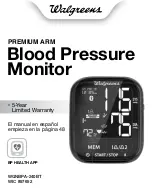
5
ABOUT BLOOD PRESSURE
Blood pressure is the pressure exerted on the artery walls while blood
flows through the arteries. The pressure measured when the heart
contracts and sends blood out of the heart is systolic (highest) blood
pressure. The pressure measured when the heart dilates with blood
flowing back into the heart is called diastolic (lowest) blood pressure.
Both the systolic and diastolic pressure are necessary for a physician to
evaluate the status of a patient’s blood pressure.
Why Measure Your Blood Pressure?
Among today’s various health problems, those associated with high
blood pressure are very common. High blood pressure dangerously
correlates with cardiovascular diseases. Therefore, blood pressure
monitoring is important for identifying those at risk.
Why Do My Readings Vary?
Blood pressure is a body parameter that is subject to normal variations
throughout the day. A single reading that is different from yours or
your doctor’s readings is not necessarily inaccurate. The average of
several readings, taken under similar conditions, using the same arm is
preferred for accurate blood pressure readings.
Why Are My Readings Different Than Those Taken at My
Doctor’s Office?
Many experience a phenomenon called “White Coat Hypertension”
when measured by a doctor. White Coat Hypertension refers to blood
pressure that rises above its usual level when measured in a clinical
setting, such as a doctor’s office.






































